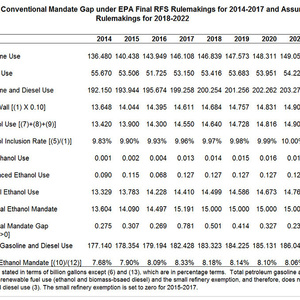Biodiesel production, consumption expected to continue increasing

Source: FarmDocDaily, University of Illinois
December 9, 2016
BY Sue Retka Schill
Two central questions arise when considering biofuels consumption through 2022, write University of Illinois ag economists Scott Irwin and Darrel Good: “When will domestic consumption of ethanol reach the statutory RFS mandate ceiling of 15 billion gallons and completely eliminate the conventional ethanol mandate gap? Second, what will be the magnitude of the push in the production and consumption of advanced biofuels to the year 2022?”
Good and Irwin published their analysis, “The RFS and Domestic Consumption of Conventional Ethanol and Biomass-Based Diesel to 2022,” in a Dec. 7 FarmDocDaily post.
Consumption of conventional ethanol could reach the statutory mandate of 15 billion gallons sooner than the market anticipates, they concluded, which could result in “substantial downward pressure on D6 RINs.” For advanced biofuels, annual production and consumption of biomass-based diesel is likely to continue to increase, with a wide variance that depends upon cellulosic ethanol.
The analysis builds on a Nov. 30 post that analyzed the impact of the U.S. EPA’s rulemaking for the renewable fuel standard (RFS) and the renewable volume obligations (RVO) for 2017 that were more aggressive than expected. In that post, they examined alternative scenarios should gasoline consumption be higher than the projections used by EPA. “We found that regardless of the assumptions used, the EPA was true to their intention of pushing the conventional ethanol mandate beyond the blend wall,” the economists concluded. In the most recent analysis, the economists extend their projections to 2022, comparing the impact of different growth-rate assumptions.
Advertisement
Irwin and Good also analyzed the relationship between the RVOs for cellulosic biofuels, which have seen substantial write downs from the statutory levels, and the RVOs for advanced biofuels. When the cellulosic RVO is written down, the EPA is authorized to write down the total advanced biofuels mandate, which includes cellulosic, by a similar amount. “For the years 2014 through 2017, the write downs in the total advanced mandates were less than the write downs in the cellulosic mandates. The magnitude of those differences represents the magnitude of the push in production and consumption of advanced biofuels,” they write. The advanced biofuels push for 2017, they calculate, is 520 million gallons, “based on our projections of gasoline and diesel consumption and consumption of undifferentiated ethanol and other nonethanol advanced biofuels.” If the gaps are filled by biomass-based diesel, the implied increase for biodiesel is substantial.
To read the entire analysis, click here.
Advertisement
Related Stories
The biodiesel industry has been facing turbulence, but the release of long-overdue policy could course-correct.
The U.S. House of Representatives early on May 22 narrowly passed a reconciliation bill that includes provisions updating and extending the 45Z clean fuel production tax credit. The bill, H.R. 1, will now be considered by the U.S. Senate.
U.S. EPA Administrator Lee Zeldin on May 21 stressed the agency is working “as fast as humanly possible” to finalize a rulemaking setting 2026 RFS RVOs during a hearing held by the U.S. Senate Committee on Environment and Public Works.
Clean Fuels Alliance America on May 22 delivered a letter to U.S. EPA Administrator Lee Zeldin, urging him to set the 2026 RFS biomass-based diesel volume at no less than 5.25 billion gallons and allow continued growth in the 2027 volumes.
Luxury North Dakota FBO, Overland Aviation—together with leading independent fuel supplier, Avfuel Corp.— on May 19 announced it accepted a 8,000-gallon delivery of sustainable aviation fuel (SAF) on May 12.
Upcoming Events










